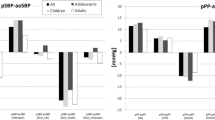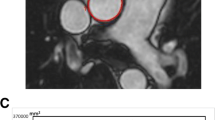Abstract
Introduction
Aortic augmentation index (AIx) is a commonly used measure to evaluate the arterial stiffness of large elastic arteries. It has been used as an indicator for cardiovascular risk in clinical practice.
Aim
To evaluate the difference in the aortic AIx assessed from the left and the right hand in a group of healthy young adults using SphygmoCor and Arteriograph devices.
Methods
32 subjects were enrolled in this study (27 ± 7 years), 16 male and 16 female volunteers participated. Equally, half of the gender groups were left-handed and another half right-handed.
Results
It was found that the aortic AIx values assessed from the pressure waveforms of the right and the left hand are different and significantly higher in the left hand. Using a SphygmoCor device, the mean difference between the aortic AIx values from the right and the left hand among the whole study group was found − 4.78 ± 4.31% and using an Arteriograph the aortic AIx values were − 3.92 ± 3.90%. Aortic AIx values assessed from the right and the left hand were linearly related to each other for both devices. Moreover, it was found that the values of the aortic.
Conclusions
AIx are independent of the subject’s handedness. It has to be pointed out that subjects who cannot be subjected to assessment of the aortic AIx from one side of the body could have different AIx values estimated from the recorded pressure waveform from the other bodyside.



Similar content being viewed by others
References
Herrington W, Lacey B, Sherliker P, Armitage J, Lewington S. Epidemiology of atherosclerosis and the potential to reduce the global burden of atherothrombotic disease. Circ Res. 2016;118:535–46. https://doi.org/10.1161/CIRCRESAHA.115.307611.
Durham AL, Speer MY, Scatena M, Giachelli CM, Shanahan CM. Role of smooth muscle cells in vascular calcification: implications in atherosclerosis and arterial stiffness. Cardiovasc Res. 2018;114(4):590–600. https://doi.org/10.1093/cvr/cvy010.
Butlin M, Avolio AP. Age-related changes in the mechanical properties of arteries. New York: Springer; 2015. p. 37–74. https://doi.org/10.1007/978-3-319-03970-1_3.
Low Wang CC, Hess CN, Hiatt WR, Goldfine AB. Clinical update: cardiovascular disease in diabetes mellitus atherosclerotic cardiovascular disease and heart failure in type 2 diabetes mellitus—mechanisms, management, and clinical considerations. Circulation. 2016;133(24):2459–502. https://doi.org/10.1161/circulationaha.116.022194.
Schiffrin EL, Lipman ML, Mann JF. Chronic kidney disease, effects on the cardiovascular system. Circulation. 2007;116(1):85–97. https://doi.org/10.1161/circulationaha.106.678342.
García-Ortiz L, Recio-Rodríguez JI, Martín-Cantera C, Cabrejas-Sánchez A, Gómez-Arranz A, González-Viejo N, Nicolás EIS, Patino-Alonso MC, Gómez-Marcos MA. Physical exercise, fitness and dietary pattern and their relationship with circadian blood pressure pattern, augmentation index and endothelial dysfunction biological markers: EVIDENT study protocol. BMC Public Health. 2010;10:233. https://doi.org/10.1186/1471-2458-10-233.
Betge S, Kretzschmar D, Figulla HR, Lichtenauer M, Jung C. Predictive value of the augmentation index derived vascular age in patients with newly diagnosed atherosclerosis. Heart Vessels. 2017;32:252. https://doi.org/10.1007/s00380-016-0868-0.
McEniery CM, Hall YR, Qasem A, Wilkinson IB, Cockcroft JR. Normal vascular aging: differential effects on wave reflection and aortic pulse wave velocity: the anglo-cardiff collaborative trial (ACCT). J Am Coll Cardiol. 2005;46(9):1753–60. https://doi.org/10.1016/j.jacc.2005.07.037.
Fantin F, Mattocks A, Bulpitt CJ, Banya W, Rajkumar C. Is augmentation index a good measure of vascular stiffness in the elderly? Age Ageing. 2007. https://doi.org/10.1093/ageing/afl115.
Wilkinson IB, MacCallum H, Flint L, Cockcroft JR, Newby DE, Webb DJ. The influence of heart rate on augmentation index and central arterial pressure in humans. J Physiol. 2000;525:263–70.
Butlin M, Qasem A. Large artery stiffness assessment using sphygmocor technology. Pulse. 2017;4(4):180–92. https://doi.org/10.1159/000452448.
Rajzer MW, Wojciechowska W, Klocek M, Palka I, Brzozowska-Kiszka M, Kawecka-Jaszcz K. Comparison of aortic pulse wave velocity measured by three techniques: Complior, SphygmoCor and Arteriograph. J Hypertens. 2008;26(10):2001–7. https://doi.org/10.1097/HJH.0b013e32830a4a25.
Horváth IG, Németh A, Lenkey Z, Alessandri N, Tufano F, Kis P et al. Invasive validation of a new oscillometric device (Arteriograph) for measuring augmentation index, central blood pressure and aortic pulse wave velocity. J Hypertens. 2010;28(10):2068–75. https://doi.org/10.1097/HJH.0b013e32833c8a1a.
Kohara K, Tabara Y, Yamazaki M, Kobayashi T, Miyawaki Y, Miki T. Variability of radial augmentation index including right–left difference. J Hypertens. 2006;25(2):168.
Hwang MH, Yoo JK, Kim HK, Hwang CL, Mackay K, Hemstreet O et al. Validity and reliability of aortic pulse wave velocity and augmentation index determined by the new cuff-based SphygmoCor Xcel. J Hum Hypertens. 2014;28(8):475–81. https://doi.org/10.1038/jhh.2013.144.
Acknowledgements
We thank the study participants for their time and effort.
Author information
Authors and Affiliations
Corresponding author
Ethics declarations
Funding
The research was funded partly by the Estonian Ministry of Education and Research under institutional research financing IUT 19-2 and by Estonian Centre of Excellence in IT (EXCITE) funded by the European Regional Development Fund.
Conflict of interest
All other authors declare no conflict of interest.
Ethical approval
This study has been approved by the Tallinn Ethics Committee on Medical Research at the National Institute for Health Development, Estonia.
Informed consent
Written informed consent was obtained from each patient.
Rights and permissions
About this article
Cite this article
Einstein, S., Pilt, K., Palmar, M. et al. Aortic Augmentation Index is Dependent on Bodyside in Healthy Young Subjects. High Blood Press Cardiovasc Prev 26, 375–382 (2019). https://doi.org/10.1007/s40292-019-00335-3
Received:
Accepted:
Published:
Issue Date:
DOI: https://doi.org/10.1007/s40292-019-00335-3




